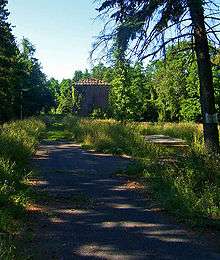Catskill Aqueduct

.jpg)
The Catskill Aqueduct, part of the New York City water supply system, brings water from the Catskill Mountains to Yonkers where it connects to other parts of the system.
History
Construction commenced in 1907. The aqueduct proper was completed in 1916 and the entire Catskill Aqueduct system including three dams and 67 shafts was completed in 1924.[1] The total cost of the aqueduct system was $177 million ($2.4 billion in 2015 dollars).[2]
Specifications
The 163-mile (262 km) aqueduct consists of 55 miles (89 km) of cut and cover aqueduct, over 28 miles (45 km) of grade tunnel, 35 miles (56 km) of pressure tunnel, six miles (10 km) of steel siphon, and 39 miles (63 km) of conduit. The 67 shafts sunk for various purposes vary in depth from 174 to 1,187 feet (362 m).[3] Water flows by gravity through the aqueduct at a rate of about 4 feet per second (1.2 m/s).[4]
The Catskill Aqueduct has an operational capacity of about 550 million US gallons (2,100,000 m3) per day north of the Kensico Reservoir in Valhalla, New York. Capacity in the section of the aqueduct south of Kensico Reservoir to the Hillview Reservoir in Yonkers, New York is 880 million US gallons (3,300,000 m3) per day.[5] The aqueduct normally operates well below capacity with daily averages around 350–400 million US gallons (1,500,000 m3) of water per day. About 40% of New York City's water supply flows through the Catskill Aqueduct.
Geography
The Catskill Aqueduct begins at the Ashokan Reservoir in Olivebridge, New York, located in Ulster County. From the Ashokan Reservoir, the aqueduct traverses in a southeasterly direction through Ulster, Orange, and Putnam counties. It tunnels first beneath the Wallkill River in the town of Gardiner in Ulster County before flowing toward Orange County, New York. It crosses 1,100 feet (340 m) below the Hudson River bed at Storm King Mountain in Orange County before reaching Putnam County on the east side of the river at Breakneck Mountain. The aqueduct transports water from Ashokan as well as the Schoharie Reservoir, which feeds into Ashokan.[6]
The aqueduct then enters Westchester County, New York, and flows to the Kensico Reservoir, which also receives water from the City's Delaware Aqueduct. It continues from the Kensico reservoir and terminates at the Hillview Reservoir in Yonkers. The Hillview Reservoir then feeds City Tunnels 1 and 2, which bring water to New York City. If necessary, water can be made to bypass both reservoirs.
References
- ↑ A history of the NYC water supply system - Merguerian, 2000c
- ↑ Catskill Water Supply: A General Description and Brief History
- ↑ A history of the NYC water supply system - Merguerian, 2000c
- ↑ Water Supply and Distribution Timeline - Greatest Engineering Achievements of the Twentieth Century
- ↑ New York City water supply system
- ↑ The Hudson River Guidebook By Arthur G. Adams
See also
- Delaware Aqueduct
- New York City Water Supply System
- Frank E. Winsor the engineer in charge of construction of 32 miles (51 km) of the Aqueduct.
Coordinates: 41°50′55″N 74°8′14″W / 41.84861°N 74.13722°W